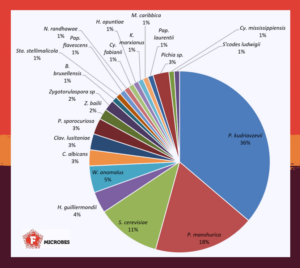The African marula tree is a wild tree with very sweet, plum-like fruits. Spontaneous fermentation of marula fruits produces ethanol and other volatile compounds. These fermentation products attract several animals, including elephants which, according to myths, get tipsy on fermented marula. It is still not known which yeast strains are responsible for fermentating the marula fruit. Dr. Nerve Zhou, one of the authors of the study “The marula and elephant intoxication myth: assessing the biodiversity of fermenting yeasts associated with marula fruits (Sclerocarya birrea)” in FEMS Microbes, explains what we can learn from the marula fermentation process in this #BehindThePaper interview for the #FEMSmicroBlog.
Why is your research study important for society?
Our study focuses on the yeast diversity of marula fruits, native to Southern Africa and also found in East and Western parts of Africa. The marula fruit is the size of a plum and rich in sugars that are fermented by different yeast strains in and on the fruit.
Based on this spontaneous fermentation, a traditional alcoholic beverage is produced, known as marula in South Africa and Botswana and mukumbi in Zimbabwe. A myth says that elephants get intoxicated by the alcohol from the fermented fruit. The myth is certainly fascinating for both African societies and tourists, but not much research has been done to verify if there is truth behind it.
We wanted to shed light on the diversity of yeasts responsible for producing this traditional beverage, while also investigating the myth with a scientific approach. Our study indeed supported the idea that elephants get intoxicated by the ethanol in the fermented fruit.
This could help elephant caretakers understand the animal’s drunken trance and strange behavior. We also hoped for a greater appreciation for marula trees and the ecosystems they support, as well as for the importance of conserving elephants and their habitats.
What is the significance of your paper for microbiologists outside your field?
While our paper focuses on the biodiversity of alcohol-fermenting yeasts, we also isolated and identified various other yeast species. These findings could offer valuable insights into microbial ecology important in other areas of microbiology.
Clinical microbiologists may want to investigate the impact of these microbes on human health. This is especially important since many people in rural Africa eat marula fruits straight from the trees without washing them.
Some insects and mammals primarily feed on marula fruits, likely impacting their intestinal microbiome. Industrial microbiologists may want to consider marula fruits potential sources for novel yeast strains for fermentation applications.

What can policymakers learn from your research results?
The huge diversity of potentially useful yeasts found in wild marula fruits draws attention to the importance of preserving and conserving wild fruit trees. Policies to protect the indigenous marula tree are in place but may need to be enforced more strongly to minimize the impact of anthropogenic activities on biodiversity.
Our research also offers insights into the interconnectedness of ecosystems, the value of indigenous knowledge, and the importance of interdisciplinary approaches. Policymakers are therefore encouraged to be aware of these factors to inform policies related to wildlife and cultural preservation, as well as sustainable development.
Why did you choose to dive into the topic of this paper?
Our main drive was the cultural significance of the marula fruit and the scientific curiosity about how this fruit impacts elephants. Previous researchers argued that it is impossible to inebriate the gigantic elephant with the small doses of ethanol found in the fermented fruit. The long-standing myth thus represented an intriguing line of investigation, and we were fascinated by how microbes and their activities could provide answers to this phenomenon.
Moreover, the physiological diversity of Saccharomyces cerevisiae strains isolated from wild fruits provides endless possibilities for modern bioprocessing and biotechnology. In a paper yet to be published, we note that these Saccharomyces strains are different from the yeasts used in industrial beer and wine fermentations.
You decided to opt for the Transparent Peer Review route offered by FEMS Microbes. What motivated you to do so, and what are the benefits in your opinion?
The study investigated a controversial subject and we wanted to know what other experts in the field had to say about our findings. Throughout the peer review process offered by FEMS Microbes, we learnt a lot more about this subject and how to present our findings in the best way.
- Read the paper “The marula and elephant intoxication myth: assessing the biodiversity of fermenting yeasts associated with marula fruits (Sclerocarya birrea)” by Makopa et al. (2023) in FEMS Microbes.

Dr Nerve Zhou obtained a first class Honours Degree in Biological Sciences at the Midlands State University in Zimbabwe and studied a Master of Sciences in Biotechnology at the University of the Witwatersrand (South Africa). He obtained his PhD in Biology from Lund Universitet (Sweden) with Specialization in Genetics. Now a Senior Lecturer and researcher at the Botswana International University of Science and Technology, his current research focuses on the search for alternative alcohol-fermenting yeasts. He seeks to isolate yeasts from wild fruits and traditional beverages to complement studies on the ecology and biodiversity of yeasts and tap into their potential as industrial strains.
About this blog section
#BehindThePaper posts on the #FEMSmicroBlog aim to bring science closer to different audiences and to tell more about the scientific or personal journey to come to the results.
| Do you want to be a guest contributor? |
| The #FEMSmicroBlog welcomes external bloggers, writers and SciComm enthusiasts. Get in touch if you want to share your idea for a blog entry with us! |
